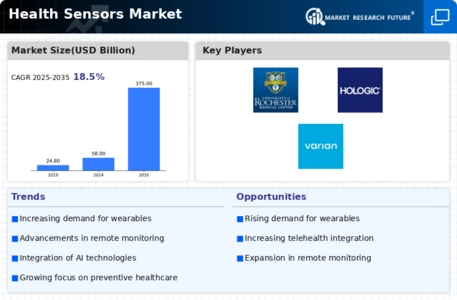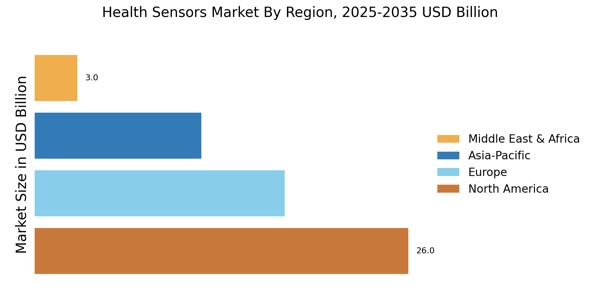Advancements in Sensor Technology
Technological advancements in sensor technology are playing a pivotal role in shaping the Health Sensors Market. Innovations such as miniaturization, improved accuracy, and enhanced connectivity are enabling the development of more sophisticated health monitoring devices. For instance, the introduction of biosensors that can detect specific biomarkers in bodily fluids is revolutionizing the way health data is collected and analyzed. This trend is expected to drive market growth, as healthcare providers increasingly rely on accurate and real-time data for patient management. Furthermore, the integration of Internet of Things (IoT) capabilities into health sensors is likely to facilitate seamless data sharing between devices and healthcare systems, thereby enhancing the overall efficiency of health monitoring solutions.
Rising Incidence of Chronic Diseases
The Health Sensors Market is significantly influenced by the rising incidence of chronic diseases worldwide. Conditions such as diabetes, cardiovascular diseases, and respiratory disorders are becoming increasingly prevalent, necessitating continuous monitoring and management. Health sensors play a crucial role in this context, as they enable patients to track their health metrics and share data with healthcare providers. Recent statistics indicate that chronic diseases account for approximately 70% of all deaths globally, underscoring the urgent need for effective monitoring solutions. As healthcare systems strive to improve patient outcomes and reduce costs associated with chronic disease management, the demand for health sensors is likely to escalate, driving growth in the market.
Growing Focus on Preventive Healthcare
The Health Sensors Market is witnessing a growing focus on preventive healthcare, which is reshaping consumer behavior and healthcare practices. As individuals become more proactive about their health, there is an increasing demand for devices that can provide continuous health monitoring and early detection of potential health issues. This shift towards preventive measures is supported by healthcare policies that emphasize the importance of early intervention and chronic disease management. Market data suggests that the preventive healthcare segment is expected to expand significantly, with a projected increase in the adoption of health sensors that facilitate regular health assessments. This trend not only benefits consumers but also alleviates the burden on healthcare systems by reducing the incidence of severe health conditions.
Increasing Demand for Wearable Health Devices
The Health Sensors Market is experiencing a notable surge in demand for wearable health devices. These devices, which include smartwatches and fitness trackers, are increasingly being adopted by consumers for their ability to monitor vital signs and physical activity in real-time. According to recent data, the wearable health technology segment is projected to grow at a compound annual growth rate of approximately 25% over the next five years. This growth is driven by a heightened awareness of personal health and wellness, as well as the convenience offered by these devices. As consumers seek to take control of their health, the integration of advanced sensors into wearables is likely to enhance their functionality, thereby further propelling the Health Sensors Market.
Integration of Health Sensors in Smart Home Systems
The integration of health sensors into smart home systems is emerging as a transformative trend within the Health Sensors Market. As smart home technology becomes more prevalent, the incorporation of health monitoring devices into these systems offers consumers enhanced convenience and peace of mind. For example, sensors that monitor vital signs can be integrated with home automation systems to alert caregivers or family members in case of emergencies. This trend is expected to gain traction as the aging population seeks solutions that allow them to live independently while ensuring their health is monitored. Market forecasts suggest that the smart home health technology segment will experience substantial growth, further propelling the Health Sensors Market.


















Leave a Comment